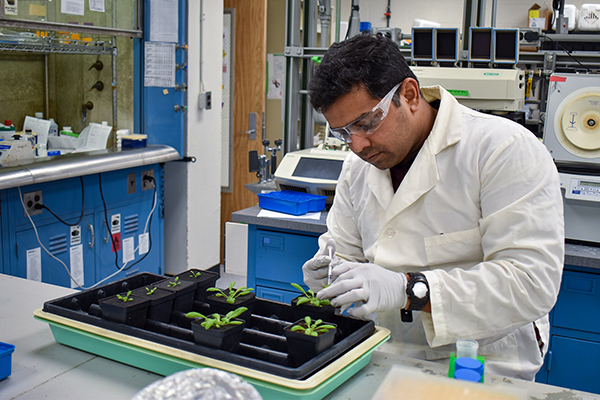Discovering the secrets of plant defense
Article Highlights
- Researchers at Michigan State University have discovered a protein that plants use to coordinate defense response to pathogens.
- The finding, reported in the journal Nature Communications, could ultimately help researchers develop more productive and resilient crops.
- Like humans, plants launch immune responses to threats like fungi, bacteria and other microbes. But the proteins that coordinate these responses and how they work are still largely mysterious to scientists.
- In the new report, the MSU team has shown that a protein known as TGNap1 plays a key role in transporting antimicrobial enzymes and other proteins out of plant cells.
- The research at Michigan State University was conducted primarily by Deepak Bhandari in a team led by Federica Brandizzi in the MSU-DOE Plant Research Laboratory.
Plants defend themselves against fungi, bacteria and other pathogens by secreting a mixture of enzymes and antimicrobial proteins. But the identity and role of proteins that play traffic controller inside a plant cell and coordinate the movement of this mixture have been a looming enigma.

Now, Michigan State University scientists have illuminated one piece of this puzzle that helps understand how plants limit pathogen growth. The researchers have discovered that a protein known as TGNap1 plays a key role in transporting antimicrobial proteins out of plant cells.
The study, recently published in the journal Nature Communications, was led by Deepak Bhandari and Federica Brandizzi in the MSU-DOE Plant Research Laboratory.
“There are multiple pathways in and out of a plant cell,” said Bhandari, a postdoctoral research associate in the Brandizzi Lab. “We have learned the TGNap1 protein controls one of these pathways.”
“Defining the identity of proteins that control traffic of defense compounds in cells is of paramount significance for boosting crop productivity and yield,” said Brandizzi, an MSU Research Foundation Professor and University Distinguished Professor in the Department of Plant Biology.
“By establishing a role of TGNap1 in antagonizing pathogens, Deepak’s findings have broadened our understanding of how plants protect themselves from pathogens and identified a new component that can be further studied for crop improvement,” Brandizzi said.
Ready for battle
Like humans, plants have immune systems to fight off pathogens. But, unlike humans, plant immune systems aren’t adaptive. That means the plants have an array of predetermined responses to try and deal with any foreign substance.

Postdoctoral researcher Deepak Bhandari in the MSU-DOE Plant Research Laboratory injects an Arabidopsis plant with a bacterial pathogen to study its immune response. Credit: Kara Headley/MSU-DOE Plant Research Laboratory
“Essentially, plants are in an active state of battle-readiness at all times,” Bhandari explained.
Living in that state requires an important balance: Plants can’t be too overzealous or too lax.
“You don’t want to spend a lot of resources defending yourself against a non-existent threat rather than using the resources to grow,” Bhandari said. “But, at the same time, you can’t afford to be too slow when you’re actually under attack.”
This is part of the reason why plants have evolved multiple pathways to shuttle antimicrobial proteins out of cells to an infection site. Plants have backup in case a particular pathway isn’t activated or able to respond.
Many of these pathways are still mysterious to plant biologists, who are working to puzzle them all out. The discovery gives them a new piece to work with.
The research expands on earlier work done in Brandizzi’s lab, which discovered the TGNap1 protein in the trans-Golgi network, or TGN.
The trans-Golgi network is basically a sorting station at the intersection of pathways that controls protein traffic into and out of cells, the researchers said. The network and its support proteins are essential for the proper functioning of many organisms.
There are still myriad questions about how the TGN operates. For his part, Bhandari has many of his own questions that he plans to investigate related to the newly discovered pathway controlled by TGNap1.

For example, does the pathway target specific pathogens or is it more of a generalist? Does TGNap1 work with other proteins to control this pathway and, similarly, is TGNap1 itself involved in other pathways?
Another interesting question is what the TGNap1 protein would do in other plants. This research was conducted in Arabidopsis thaliana, a widely used model organism in plant research. But what would happen if researchers put the protein in, say, a tomato plant?
By taking on these fundamental studies to develop a more intimate understanding of plants, Bhandari and his colleagues are working toward a future when crops can be even more adept at protecting themselves.
“There is a very famous saying by Sun Tzu,” Bhandari said, “that roughly translates to, ‘you need to know yourself first before you know the enemy.’ It’s the same here.
“Unless we know all the pathways that contribute to plant immunity, it’s very difficult for us to understand what the pathogen is trying to attack and how to defend it. Essentially, we’re contributing to what will be considered fundamental knowledge in five years.”
This work was funded primarily by the MSU Research Foundation. It was also supported by the U.S. Department of Energy Great Lakes Bioenergy Research Center; the U.S. Department of Energy through the SLAC National Accelerator Laboratory; the Chemical Sciences, Geosciences and Biosciences Division, Office of Basic Energy Sciences, Office of Science in the U.S. Department of Energy; and the National Institutes of Health.
Banner image: After injecting Arabidopsis thaliana with the plant pathogen Pseudomonas syringae, Michigan State University researchers were able to probe a plant’s defense response. Credit: Kara Headley/MSU-DOE Plant Research Laborator